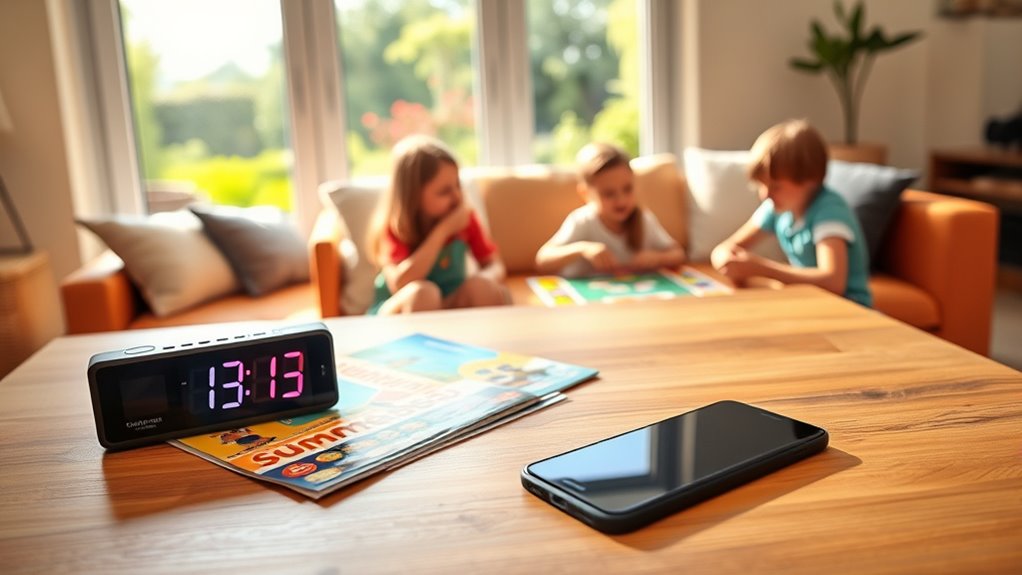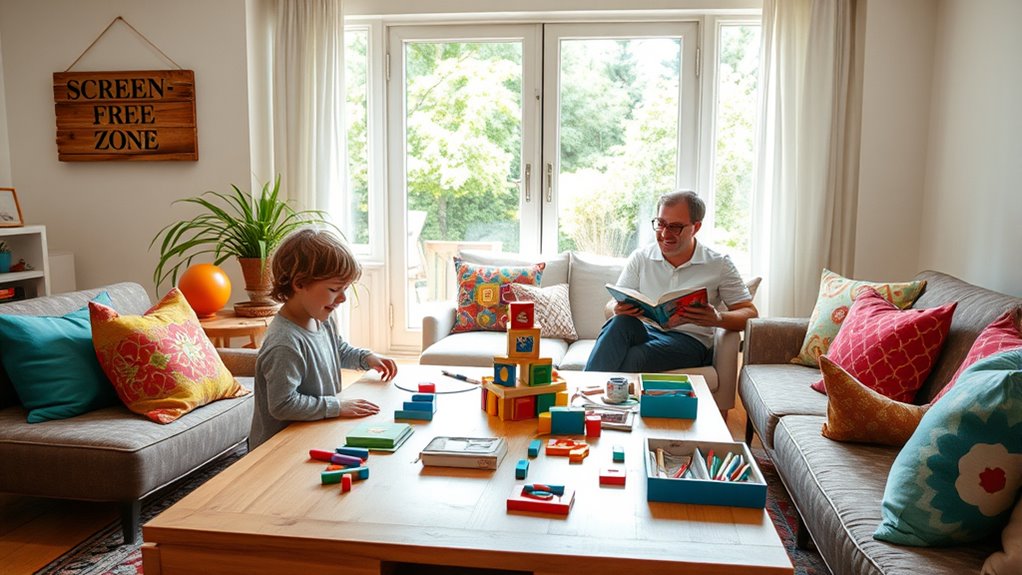Managing screen time during summer break is essential. Set clear rules, limiting non-academic screen time to 1-2 hours daily. Involve your kids in creating a fun summer schedule that prioritizes outdoor activities and hobbies. Designate screen-free zones in your home, like dining areas, to foster quality family interactions. Use parental controls to guarantee safe content. By establishing these practices, you can help your child develop healthier habits. You’ll soon discover even more tips to enhance their summer experience.
Key Takeaways
- Set clear screen time limits of 1-2 hours daily and communicate them consistently to your children.
- Involve kids in creating a summer schedule that prioritizes outdoor activities and hobbies.
- Designate specific screen-free zones, like dining areas and bedrooms, to encourage healthier habits.
- Implement parental control apps to manage screen time and block inappropriate content effectively.
- Establish a “Summer Routine Checklist” to track chores, educational tasks, and outdoor play.
Establishing Clear Screen Time Rules for Summer

To guarantee a healthy balance between screen time and other summer activities, it’s essential to establish clear screen time rules for your family.
Experts recommend limiting non-academic screen time to 1-2 hours per day for school-aged kids. Communicate these limits clearly to everyone, ensuring consistency.
You might want to involve your children in creating a summer schedule that prioritizes outdoor play, reading, and creative hobbies. Set specific times for chores and educational tasks, and consider a “Summer Routine Checklist” to keep track.
Establish boundaries, like no screens at the dinner table or before bedtime, to encourage family interaction and promote better sleep.
Consistency in enforcing these rules will help maintain a balanced approach to screen time this summer.
Understanding the Risks of Excessive Screen Time

While summer breaks offer a chance for kids to unwind, excessive screen time can pose significant risks to their overall well-being. Increased screen exposure is linked to higher rates of anxiety and depression, particularly in teens. It can also hinder cognitive development, affecting academic performance and executive functioning.
You might notice your child becoming socially withdrawn, struggling to interpret emotions, and having difficulty forming healthy relationships.
Physically, prolonged screen use contributes to obesity, sleep disturbances, and even eyesight issues. Additionally, it can disrupt the quality of interactions you have with your child, leading to weakened parent-child bonds.
Encouraging Outdoor Activities and Hobbies

Encouraging your child to engage in outdoor activities and hobbies not only fosters their physical health but also nurtures their creativity and social skills. With 54% of Americans participating in outdoor recreation, you’re in good company! Consider activities like biking, which boasts a 29.9% participation rate among kids, or camping and fishing for a fun family adventure. Engaging in sustainable outdoor practices can also enhance your child’s appreciation for nature and the environment. Additionally, introducing portable camping toilets can make family camping trips more comfortable and convenient, allowing for more enjoyable outdoor experiences. Creating safe living spaces for outdoor play can further enhance your child’s enjoyment and safety during these activities.
Local parks are perfect spots for these activities, providing accessible spaces for community engagement. Structured programs, such as day camps, can further enhance your child’s summer by offering organized outdoor experiences. Additionally, incorporating healthy outdoor environments can significantly improve children’s overall well-being and enjoyment during these activities.
Implementing Screen-Free Zones and Times at Home

After engaging in outdoor activities and hobbies, it’s important to find a balance by implementing screen-free zones and times at home.
Start by auditing your family’s current screen habits; track usage and identify high-use areas like the dining room or bedrooms. Designate these spaces as screen-free to enhance family interactions during meals and promote better sleep. Additionally, creating healthy habits can encourage your family to engage in more screen-free activities, as research indicates that extended separations from screens can improve emotional connections. Maintaining a clean home environment can also reduce allergens and improve overall well-being, making it a more inviting space for family interactions.
Establish clear rules, like no screens during mealtimes or an evening curfew before bed. Involve everyone in the process to guarantee buy-in and understanding.
Create a daily schedule that includes screen-free periods, and encourage compliance through incentives. By setting boundaries, you foster a healthier relationship with screens while prioritizing family bonding and well-being. Incorporating mindfulness practices can further enhance the effectiveness of these routines.
Utilizing Parental Controls for Safe Screen Use

Managing your child’s screen time can feel overwhelming, but utilizing parental controls offers a practical solution to confirm safe and responsible use. Various parental control apps, like Screen Time, allow you to manage screen time across devices, block apps, and filter web content.
Most devices come with built-in features such as Apple’s Screen Time or Android’s Digital Wellbeing, enabling you to set time limits and content restrictions. Tools like Microsoft Family Safety help manage screen time across multiple devices.
You can also guarantee consistent control with passcode protection to prevent unauthorized changes. Collaborate with other guardians by granting them access to these settings, making it easier to maintain a safe digital environment for your child.
Managing Screen Time Expectations During Family Trips

While family trips are a great opportunity for bonding and exploration, setting clear expectations around screen time can help guarantee everyone enjoys the experience.
Before you head out, communicate your screen time rules to your kids, making sure they understand the limits. Plan engaging activities, like beach outings or adventure parks, to minimize screen reliance.
Designate screen-free zones, such as during meals or at scenic spots, to foster family interaction. You can schedule specific times for device use, like in the evenings.
Encourage exploration of local areas and involve them in travel games, ensuring they stay engaged without screens. By modeling healthy tech habits yourself, you’ll inspire your children to embrace these expectations enthusiastically. Additionally, consider establishing clear rules for screen time that everyone can agree upon to promote a harmonious family environment.
Frequently Asked Questions
How Can I Effectively Communicate Screen Time Rules to My Child?
To effectively communicate screen time rules to your child, start by explaining the reasons behind the limits. Use simple language they can understand.
Set clear expectations, like daily time limits, and involve them in the process by asking for their input.
Create a visual schedule to help them see when they can use screens.
Finally, reinforce the rules consistently and praise them when they follow them, making it a positive experience.
What Are Some Signs My Child Is Spending Too Much Time on Screens?
If you notice your child becoming irritable or aggressive after screen use, that’s a sign they might be overstimulated.
Look for emotional shutdowns, difficulty maintaining eye contact, or meltdowns. Eye fatigue, headaches, and dry eyes can also indicate too much screen time.
If they prefer screens over playing outside or socializing, that’s concerning.
Establishing boundaries is essential to help them maintain a healthy balance and develop essential social skills.
How Can I Motivate My Child to Engage in Screen-Free Activities?
If you think your child’s only passion is binge-watching shows, think again!
To motivate them to engage in screen-free activities, become their activity detective. Set up exciting scavenger hunts, plan bike rides, or create a DIY arts and crafts station.
You’re the one who can turn a mundane day into an adventure! Encourage them to choose the activities, and watch their enthusiasm soar as they explore the world beyond the screen.
Are There Specific Apps to Help Limit Screen Time for Kids?
Yes, there are several apps designed to help you limit screen time for your kids.
Apps like Screen Time Labs allow you to set daily limits, block certain apps, and even track device activity. You can establish clear rules and encourage your child to earn extra screen time through completing tasks.
These tools make it easier for you to manage multiple devices and guarantee a balanced approach to technology use.
What Should I Do if My Child Resists Screen Time Limits?
If your child resists screen time limits, start by involving them in setting those limits. This gives them ownership and makes them more likely to cooperate.
Use positive reinforcement—reward them when they stick to the rules. Clearly communicate your expectations and the consequences of not following them.
Also, suggest alternative activities they might enjoy, and be consistent in enforcing the rules to help reduce resistance over time.
Conclusion
As you embrace summer break, remember that striking a balance with screen time can lead to unexpected moments of joy. You might find that your child discovers a hidden talent for painting or develops a newfound love for nature walks, all while laughing with friends outside. By setting clear rules and encouraging creativity, you’ll not only manage screen time but also create unforgettable memories. Who knew that a little structure could open up a world of fun?









